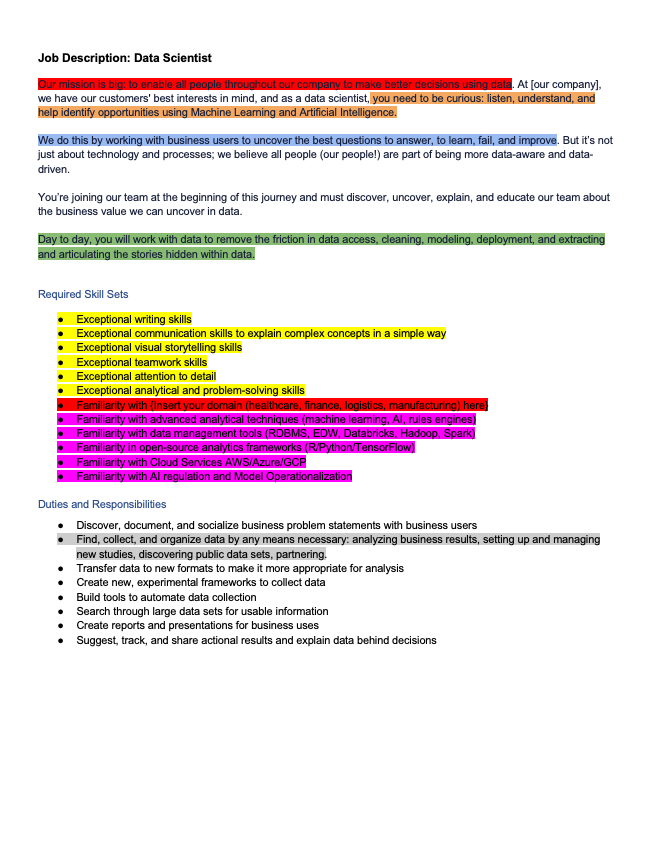-
Solution overview
Develop the technical skills that Fortune 500 enterprises and the public sector want.
-
U.S. Department of State (Cyber Advance for Women in MENA)
Build your skills and launch your career in Cybersecurity.
-
USAID Jordan (Tech for Jobs)
Increase your data analytics capabilities with this free program.
9 (Surprising) Tips for Making Your First Data Science Hires
Data science isn’t just science, especially at the start. Guest contributor Mark Palmer (SVP and General Manager of Analytics, Data Science & Data Products for TIBCO) shares how to think about your first data science hires so that your culture can embrace AI and grow.

You say you're hiring unicorns, er, data scientists. Great!
But be careful as there are at least a dozen skills a data scientist can have. And deciding on the right mix and mindset to start with is an art.
When building a data science team, the best place to begin is with less technical staff. It's best to seek out talented, humble people with broad interests, great communication skills, and an entrepreneurial mindset primed to get stuff done.
In this essay, we’re going to take a closer look at what you should keep in mind as you hire your first data professionals.
As a bonus, I provide a color-coded sample job description that reflects the the nine tips shared here. Feel free to take it, modify it to fit the particular data job for which you’re hiring, and make it your own.
9 (Surprising) Tips for Making Your First Data Science Hires
1. Put your mission first.
The essence of data science success is getting the questions right at the outset, not simply finding the right answers.
Yet a common mistake is hiring people who are too technical. Instead, start with humble communicators who connect with your mission and who are primed to spend more time listening than answering.
>> How it looks on a job description (Red): Express your mission in concrete, relatable business terms to foster team alignment with your organizational goals from the start.
Sample job description

2. Hire "intrapreneurs."
An intrapreneur is an entrepreneur who works inside a big company. These are proactive people who have hustle and humility. They know how to get things done, and when they get stuck, they'll find a way.
>> How it looks on a job description (Blue): Appeal to a job candidate's entrepreneurial spirit and willingness to embrace failure by design. For example, you might say: "We do this by working with business users to uncover the best questions to answer, to learn, to fail, and improve."
3. Don't hire solely for advanced degrees.
To reiterate, and although it might seem counterintuitive, it's best not to hire highly sophisticated, Ph.D.-level data professionals until you've reached maturity in your data science skill set and culture.
Make sure you have your arms around the problems you're trying to solve first, then hire experts.
>> How it looks on a job description (Magenta): Emphasize that you’re seeking familiarity with a wide range of technical data science skills. Enumerate a broad skill set, not a highly specialized one.
4. Hire data engineers first.
No data, no data science. Your first data hires need to know what data you have, what's missing, and how to get it.
Data engineers understand how to organize, clean, optimize, simulate, correct, understand, curate, govern, share, secure, measure, archive, and summarize data. (I call them "data dogs.")
>> How it looks on a job description (Green): Notice the emphasis on day-to-day tasks (e.g., "remov[ing] the friction in data access, cleaning, modeling, deployment, and extracting and articulating the stories hidden within data.").
5. Curate curiosity.
Data science is about discovery, not knowing. So, look for candidates who ask great questions in interviews — and don't always seem to be damn sure about everything.
>> How it looks on a job description (Orange): Spell out that you seek curiosity and related traits. For example, “As a data professional, you need to be curious and listen, understand, and help identify opportunities using Machine Learning and Artificial Intelligence."
6. Hire polymaths.
Aim for breadth of knowledge, not depth, in your first few data science hires. Seek (and develop) business acumen. And, when it comes to fundamental technical skills, look for candidates with a broad background in data engineering, statistics, machine learning, and data storytelling.
>> How it looks on a job description (Magenta): Be concrete about the specific skills you need. Bulleted lists are great for this:
- Familiarity with advanced analytical techniques (machine learning, AI, rules engines)
- Familiarity with data management tools (RDBMS, EDW, Databricks, Hadoop, Spark)
- Familiarity with open-source analytics frameworks (R/Python/TensorFlow)
- Familiarity with Cloud Services AWS/Azure/GCP
- Familiarity with AI regulation and Model Operationalization
7. Look for a community-first data science mindset.
There are tons of available algorithms in the community, including Google, AWS, and Azure services. Many of them are free, pre-configured, and good. Look for candidates who will reuse what's already there and not reinvent the wheel.
>> How it looks on a job description (Gray): "Find, collect, and organize data by any means necessary: analyzing business results, setting up and managing new studies, discovering public data sets, partnering."
8. Hunt for humility.
Data scientists can be arrogant. Be allergic to arrogance. Data science is a team sport, so hire humble, open collaborators. (You might try using a pronoun Geiger Counter interviewing approach to weed out overly confident candidates.)
>> How it looks on a job description (Orange): As with curating curiosity, you can indicate this is a value upfront in the copy. Words like “help” and “teamwork” signal that humility, collegiality are desirable.
9. Seek storytelling and creativity skills.
Writing, presentation, videography, and visual storytelling are the essential skills in the early days of data science, not deep math.
>> How it looks on a job description (Yellow): Notice the emphasis on "exceptional" required communication, creativity, and storytelling skills:
- Exceptional writing skills
- Exceptional communication skills to explain complex concepts in a simple way
- Exceptional visual storytelling skills
- Exceptional teamwork skills
- Exceptional attention to detail
The Takeaway
In the first few years of building a data-driven culture, you need more humanist skills than technical ones.
Curiosity, an intrapreneurial spirit, agility with data, teamwork, and communication skills trump technical skills in the early days — perhaps forever.
So, when making your first data science hires, build team skills in the proper order so that you’ll get on the right track for a bright, data-illuminated future.
Explore More
Discover how we help companies like yours build more diverse, high-performing data and analytics teams.
Guest contributor Mark Palmer is the SVP and General Manager of Analytics, Data Science & Data Products for TIBCO. He has responsibility for business intelligence, data science, streaming analytics, data virtualization, and metadata management products.
He’s also a member of the Correlation One Advisory Board and the recipient of numerous awards in technology innovation. Connect with Mark on LinkedIn, or follow his blog, Techno-Sapien.

.png?width=207&height=108&name=Mega%20menu%20%E2%80%93%20Featured%20Image%20Template%20(1).png)



